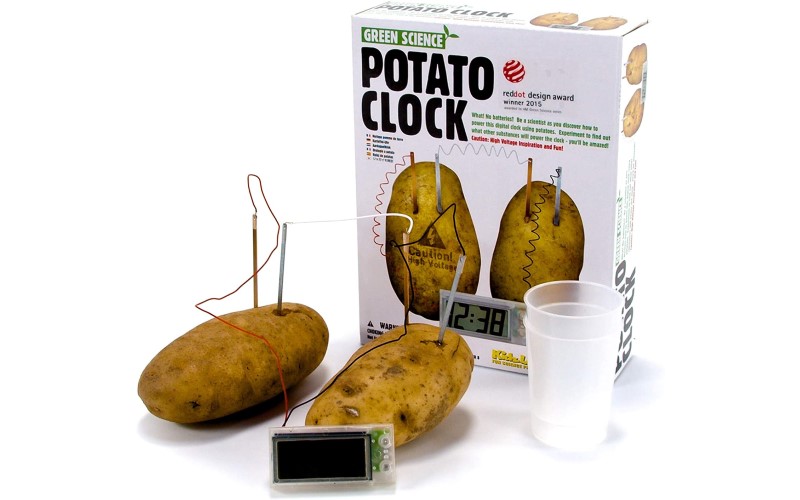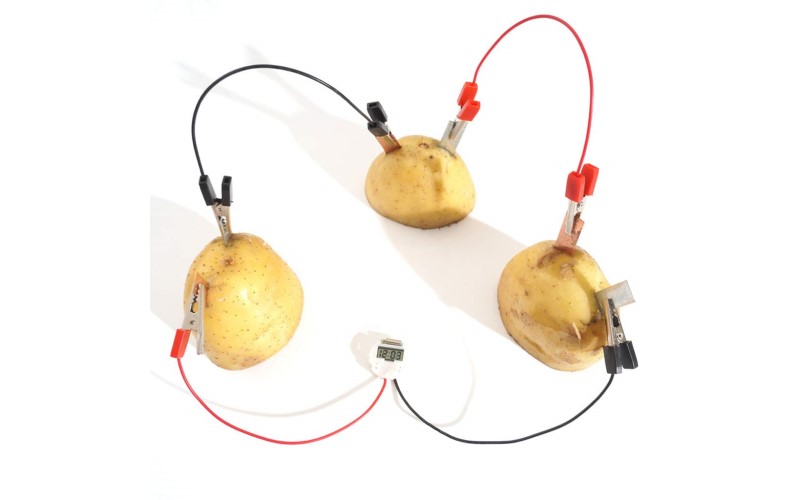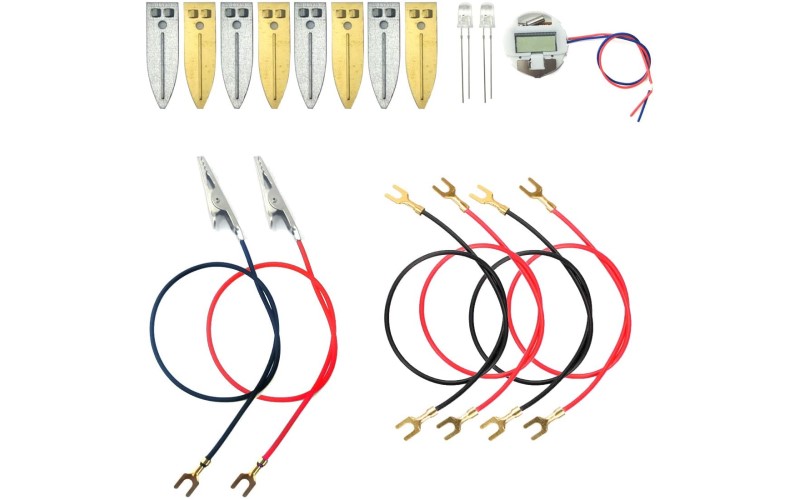Best Potato Clock Kits
Learn the science behind batteries and electricity with a potato clock kit. Here are some of the best available.

One of the most fun science experiments is turning a potato into a clock. Here are some of the best available to keep your kids entertained. All you need to supply is the potato, though some of these kits work with other fruits and vegetables, too. Our favorite is the 4M potato clock DIY kit. This kit is safer for young kids to do themselves and comes with learning tools to foster more curiosity and interest in STEM research.

4M Potato Clock DIY Kit
Expand your mind
Create a working clock by following the instructions and using the included hardware connected to two potatoes.
Pros:
- Green science experiment
- Probes, prongs, and wiring included
- Detailed assembly instructions
Cons:
- Not for small children
This potato clock kit comes with everything you need, except the potatoes. All the wires, probes, and prongs are there along with the easy to follow instructions to help your child use their potatoes to conduct enough electricity to make a working, digital clock. Along with the instructions are lesson materials to help your child understand the science behind this kit and hopefully encourage them to keep exploring with other STEM experiments. Because this clock is powered from energy from the potatoes, no batteries are required. The 4M potatoes clock comes with small parts, so it isn’t recommended for children under 3 years old.

Skelang Fruit Battery Science Experiment
More than potatoes
Kids can use this science kit along with potatoes, apples, cucumbers, and other foods to power a digital clock.
Pros:
- Works with other produce
- Encourages more STEM experimentation
Cons:
- Clock is small
This DIY clock kit comes with crocodile clips, copper and zinc sheets, wire, and a small digital clock. And unlike other potato clock kits, it requires three potatoes, or fruit, instead of just two. But this kit also encourages your child to use the parts over and over again to discover other fruits and vegetables, or other mediums, that create enough electricity to power the clock. The digital clock that is included with this kit is a little small and isn’t designed to really be used for a long time.

EUDAX Battery Science Experience
Use beyond the kit
You can use other watches and clocks, in addition to the digital one included with this potato clock kit
Pros:
- Works with LED clocks
- Use with a variety of produce
Cons:
- Pieces can break easily
- Clocks don’t sit upright
This DIY potato clock kit comes with everything you need except the potatoes. It has several different metal sheets, wires, clips, and probes to help your child learn about electricity, how batteries work, and how to build one. Typically these kits require potatoes. This kit works with potatoes, but also with apples, oranges, tomatoes, pears, pineapples, lemons, and salt solutions. Using each gives your child more to learn and discover. A clock is included with this set so you chid knows they’ve succeeded when it is fully powered. The clock is rather on the small side and doesn’t sit straight on your table. But you can use your own watches and even LED clocks with this potato battery kit. It’s important to read instructions carefully to avoid damage to the pieces.

SEOH Fruit Potato Clock
Easy to move
This kit makes it easy to learn about science, build a potato clock, and keep it working for a few days.
Pros:
- Clock with potato stand
- Works with other produce
Cons:
- Limits the size of fruit used
This potato clock kit is built to hold your potatoes in place as your kids conduct their experiments. The base includes the digital clock built in which makes it easier to transport and use this clock for a while before dismantling it and trying it again. This SEOH kit comes with high-quality electrodes and allows kids to experiment with different voltages by swapping out potatoes for other acidic fruits and vegetables. Because the base is constructed with a specifically sized opening, some produce, including larger potatoes, may not fit inside. You can still use the kit, but your finished clock won’t be as easy to transport or use for a long period of time.
Bottom line
There isn’t a lot of differences between potato kits because they essentially all do the exact same thing. But the 4M potato clock kit is designed to be more kid-friendly and help them figure out the science behind electricity and batteries. While it is suggested that kids use this kit with adult supervision, it is also recommended for children as young as 5 years old. Other kids place the age restriction at 8. The 4M DIY science kit includes the wires, prongs, and probes you need to power up the included digital clock. The clock is big and easy to read and rests easily on a shelf or table, so your child can enjoy the fruits of their work for a few days. The instructions that come with this kit are easy to read and there are additional learning materials to help kids understand the science behind their experiences and urge more curiosity in STEM.
Sign up for the Live Science daily newsletter now
Get the world’s most fascinating discoveries delivered straight to your inbox.

Nikki writes for multiple Future Publishing brands covering topics from antivirus to kitchen appliances to SAS. She has over 15 years of research and writing experience, including eight years of testing and reviewing consumer products. Nikki earned bachelor’s degrees in both English and Political Science with a focus on empirical research. In her spare time, Nikki serves as a member of several school councils and volunteers for a local arts board.









